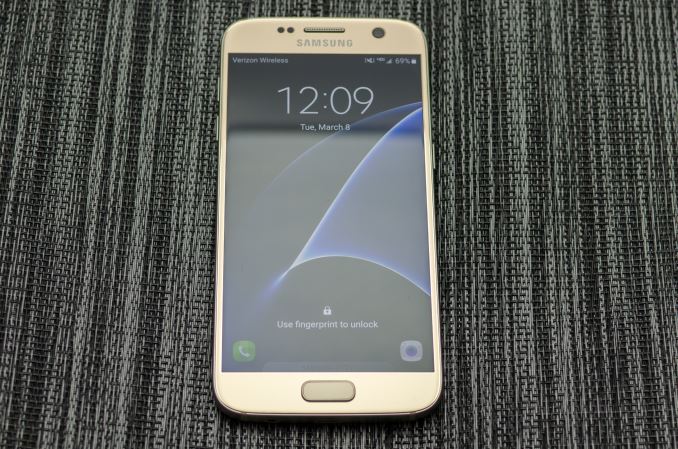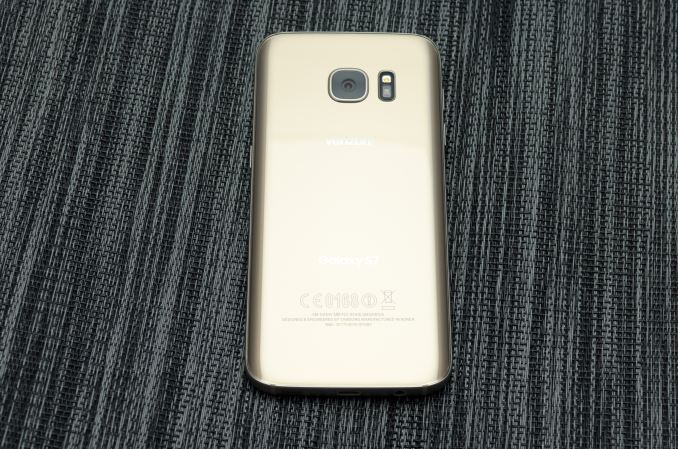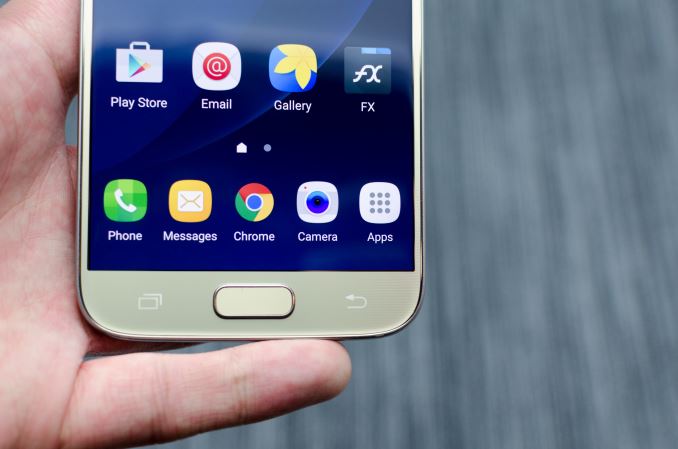The Samsung Galaxy S7 & S7 Edge Review, Part 1
by Joshua Ho on March 8, 2016 9:00 AM ESTInitial Conclusions
Even though we’re just barely scratching the surface of what we can test, the results we already have show quite a bit about the Samsung Galaxy S7. The Galaxy S line remains one of the most popular Android smartphones, and if history is any indication we can get a pretty good idea about what to expect for 2016 just by looking at the Galaxy S7 and S7 edge.
The first place we can start is design, and here we can see that the Galaxy S7 is decidedly an evolution of the Galaxy S6’s ID. However, pretty much every sharp edge has been rounded out to make the device more comfortable in the hand. The device has also been thickened in order to handle the larger battery and reduce the apparent z-height of the camera. The display size of the Galaxy S7 (non-edge) stays at 5.1 inches, and given how long Samsung has stuck to this display size it’s likely that they will be staying at this size for quite some time for their flagship.
In general, it feels like the industry has settled upon a display size somewhere between 5 to 5.5 inches for their flagship devices as going further probably won’t make a lot of sense for ergonomic reasons. I suspect Samsung and many other Android OEMs are settling into an Apple-like 2 year cadence for industrial and material design as replacement cycles lengthen, especially in the United States where subsidized phones have been almost entirely eliminated.
Meanwhile, though we haven’t had the time to run our full suite of battery life benchmarks, the data that we do have is quite interesting. At the very least, it looks like the Galaxy S7 will be a solid upgrade for those coming from the Galaxy S6 and earlier with a 15% bump in battery life or so. Anyone using a phone with an SoC not on a FinFET node will see even bigger gains to battery life, which is impressive to say the least. If you have any device with a Snapdragon 810 or 808 SoC, you’re definitely going to see major gains if you move to any device with a SoC fabricated on a FinFET node.
In terms of SoC performance, the Snapdragon 820 doesn't disappoint. In the time since testing the MDP it seems that between Qualcomm, Samsung, and Google, the trio has finally been able to optimize Snapdragon 820 for Chrome, so performance there is quite acceptable now and a pretty solid uplift over something like the Exynos 7420 or Snapdragon 810. GPU performance is also pretty much right where the Snapdragon 820 MDP was, so performance should be a good step above the A9's GT7600 GPU. Of course, we have yet to consider the power efficiency or sustainability of this performance, but turbo/overdrive performance is always relevant in the mobile space considering just how bursty almost every mobile workload is. It's pretty safe to say that Qualcomm has at least regained their footing in the SoC space, and with future SoCs they may well come to dominate the high end for performance and power once again. For now, it's looking like the race between Exynos 8890, Snapdragon 820, and Kirin 950 will be quite close.
For storage performance, to some extent it seems that the performance gains are relatively small, as the UFS 2.0 storage solutions on the Galaxy S6 and S7 are relatively similar. It’s interesting to see here that despite the now-mandatory use of FDE, the delta in performance between the Galaxy S6 and S7 in storage performance doesn’t seem to exist. This is welcome news as it wasn’t all that long ago that FDE for Android had a noticeable effect on storage performance.
On the display side, again we can see that the Galaxy S7 has a relatively similar display to the Galaxy S6. Calibration should be relatively good across the board, and AMOLED retains all of its traditional advantages including high contrast, support for wide color gamuts, low transition time, and improved power efficiency at lower average picture levels. Peak brightness is the only noticeable area where things seem to change, but I suspect that this will vary noticeably depending upon the unit. The one issue that I continue to notice here is that the edge display on the Galaxy S7 edge has a green tint at the edges, likely due to the diamond PenTile subpixel arrangement.
On the software side, Samsung’s TouchWiz UI continues to be more of the same when compared to the Galaxy Note5. The edge features continue to be somewhat interesting, but I continue to find myself thinking that there would be no difference if the same feature was implemented on the non-edge variant. Thankfully, the lag that I noticed last month in my initial hands-on time with the device seems to just have been a function of pre-release software, as the Galaxy S7 is relatively performant here. Although I’m not sure I’d go as far as to say that the Galaxy S7 is entirely free of lag. I suspect that Samsung has to balance power efficiency and responsiveness to some extent here, as while devices like the Nexus 5 can feel incredibly smooth and responsive there are very real knock-on effects in terms of practical battery life.
I’m also looking forward to testing features like Samsung Pay that are finally being deployed to the extent that I can use my personal credit card with Samsung Pay on my phone. However, out of the box TouchWiz still has some issues with an overly-neon theme, and in general things like Always-On Display already feel like they aren’t quite executed as well as they should be. I also noticed that the fingerprint scanner performance is strongly influenced by initial setup if I didn’t scan some areas on initial setup they never seemed to work very well unless I retrained the finger.
As for making a choice between the Galaxy S7 edge and Galaxy S7, there basically aren't any outside of size for the most part. There is the edge display, but by and large it feels like that's more of an aesthetic choice than a functional one. As we have seen you do get better battery life in the Galaxy S7 edge, but I don't feel like it makes sense to cross-shop the two. If you want one-handed usability, the Galaxy S7 is the only choice that makes sense. If you want a phablet, the Galaxy S7 edge is the only choice that makes sense.
Overall, I think the Galaxy S7 is looking to be one of the better devices of the year. Of course, there’s still a lot more to test, but the initial indications are already looking quite good. If you absolutely want the Galaxy S7 now, I don’t think there will be any major showstoppers present in this phone. However, if you’re looking to buy the best phone possible available this year I think it’s still too early to say where the chips will fall as Samsung's eager competitors have their own flagship phones right around the corner.














202 Comments
View All Comments
lilmoe - Thursday, March 10, 2016 - link
+ resolution+ drivers
+ software/engine
+ thermal headroom
+ etc, etc, etc.....
theduckofdeath - Tuesday, March 8, 2016 - link
If it's that trivial to make a faster GPU, I'm pretty sure Apple would have gotten a faster GPU in their phones. Faster GPU's in mobile, where battery life is really relevant is probably the trickiest part to succeed with. As you said, it basically requires you to add a ton of extra cores to make it noticeable for whichever hardware platform you're doing it on. GPU's are after all the biggest power consumers in tech these days. doubling the size of the Apple GPU would literally wreck the iPhone battery life, which I'm pretty sure you're also aware of yourself. They did after all gimp the GPU on the iPhone compared to the iPad for this exact reason.tuxRoller - Tuesday, March 8, 2016 - link
Do you mean Apple vs adreno or PVR vs adreno?I'd expect PVR to always be the most efficient GPU due to being a true tbdr.
http://blog.imgtec.com/powervr/a-look-at-the-power...
realbabilu - Wednesday, March 9, 2016 - link
You forgot the user experience. Throwing 30 fps onscreen is the minimum requirement, no need higher than that, unless Apple follows the resolution war.Apple always resolution fan in their macs, but they still think that crazy resolution is not needed, I think still true.
ciderrules - Tuesday, March 8, 2016 - link
Looks like Qualcomm spent their time creating a quality core instead of just adding more cores. Half the cores of the 8890 and by all accounts at least as fast (CPU, not GPU where it's quicker).I just wish you did a series of tests to check throttling.
tipoo - Tuesday, March 8, 2016 - link
He said part 2tuxRoller - Tuesday, March 8, 2016 - link
XDA already did a throttling test with a bunch of phones (6s, note 5, Nexus 6p, s7, etc). The results were that there was no throttling for the s7.retrospooty - Tuesday, March 8, 2016 - link
Nice... Mine is on pre-order now. I almost cant believe Samsung finally got it together and started making better devices with better build quality and bigger batteries and much less bloat, but I am very happy they did.anactoraaron - Tuesday, March 8, 2016 - link
The lack of an IR blaster is the only thing holding me back from buying the s7 edge. I use the IR blaster every day on my G4, and I assume everyone with young kids would as well. Remotes just seem to always be missing...Speedfriend - Tuesday, March 8, 2016 - link
No IR blaster!!!!! Samsung have just lost me as a customer. It is one of the best features of my S6.